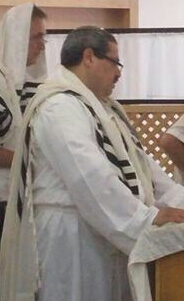Kittel on:
[Wikipedia]
[Google]
[Amazon]
220px, A kittel
A ''kittel'' ( yi, קיטל) is a white linen or cotton
robe
A robe is a loose-fitting outer garment. Unlike garments described as capes or cloaks, robes usually have sleeves. The English word ''robe'' derives from Middle English ''robe'' ("garment"), borrowed from Old French ''robe'' ("booty, spoil ...
worn by religious Ashkenazi Jews
Ashkenazi Jews ( ; he, יְהוּדֵי אַשְׁכְּנַז, translit=Yehudei Ashkenaz, ; yi, אַשכּנזישע ייִדן, Ashkenazishe Yidn), also known as Ashkenazic Jews or ''Ashkenazim'',, Ashkenazi Hebrew pronunciation: , singu ...
on holidays, in the synagogue or at home when leading the Passover seder. Kittels are sometimes worn by grooms. It is also customary for Jews to be buried in a kittel.
History
In Ashkenazic tradition, married men wear a kittel in the synagogue onYom Kippur
Yom Kippur (; he, יוֹם כִּפּוּר, , , ) is the holiest day in Judaism and Samaritanism. It occurs annually on the 10th of Tishrei, the first month of the Hebrew calendar. Primarily centered on atonement and repentance, the day' ...
. In less-traditional synagogues, religious Jews - both men and women - wear a kittel. The wearing of a ''kittel'' on the High Holidays is symbolically linked to its use as a burial shroud, and, to the verse "our sins shall be made as white as snow" (). Some wear a ''kittel'' when leading the Passover Seder
The Passover Seder (; he, סדר פסח , 'Passover order/arrangement'; yi, סדר ) is a ritual feast at the beginning of the Jewish holiday of Passover. It is conducted throughout the world on the eve of the 15th day of .
 In some communities, the Hazzan">cantor
A cantor or chanter is a person who leads people in singing or sometimes in prayer. In formal Jewish worship, a cantor is a person who sings solo verses or passages to which the choir or congregation responds.
In Judaism, a cantor sings and lead ...
In some communities, the Hazzan">cantor
A cantor or chanter is a person who leads people in singing or sometimes in prayer. In formal Jewish worship, a cantor is a person who sings solo verses or passages to which the choir or congregation responds.
In Judaism, a cantor sings and lead ...
wears a kittel on the first night of Selichot, the seventh day of the Holiday of Sukkot (also known as Hoshanah Rabbah), the Musaf prayers of Sukkot#Shemini Atzeret, Shemini Atzeret and the first day of Passover, where the prayers for  In some communities, the Hazzan">cantor
A cantor or chanter is a person who leads people in singing or sometimes in prayer. In formal Jewish worship, a cantor is a person who sings solo verses or passages to which the choir or congregation responds.
In Judaism, a cantor sings and lead ...
In some communities, the Hazzan">cantor
A cantor or chanter is a person who leads people in singing or sometimes in prayer. In formal Jewish worship, a cantor is a person who sings solo verses or passages to which the choir or congregation responds.
In Judaism, a cantor sings and lead ...rain
Rain is water droplets that have condensed from atmospheric water vapor and then fall under gravity. Rain is a major component of the water cycle and is responsible for depositing most of the fresh water on the Earth. It provides water f ...
(Tefilat HaGeshem) and dew (Tefilat HaTal) are respectively recited.
In some communities, a bridegroom
A bridegroom (often shortened to groom) is a man who is about to be married or who is newlywed.
When marrying, the bridegroom's future spouse (if female) is usually referred to as the bride. A bridegroom is typically attended by a best man ...
wears a ''kittel'' on his wedding
A wedding is a ceremony where two people are united in marriage. Wedding traditions and customs vary greatly between cultures, ethnic groups, religions, countries, and social classes. Most wedding ceremonies involve an exchange of marriage vo ...
day.
In some parts of the Jewish world, the kittel is known as a ''sargenes'', related to the Old French ''serge Serge may refer to:
*Serge (fabric), a type of twill fabric
*Serge (llama) (born 2005), a llama in the Cirque Franco-Italien and internet meme
*Serge (name), a masculine given name (includes a list of people with this name)
*Serge (post), a hitchi ...
'' as well as Latin ''serica''.source?
Symbolism
As a shroud, the ''kittel'' signifies simple attire that assures equality for all in death. Because Jewish law dictates that the dead are buried without anything else in thecoffin
A coffin is a funerary box used for viewing or keeping a corpse, either for burial or cremation.
Sometimes referred to as a casket, any box in which the dead are buried is a coffin, and while a casket was originally regarded as a box for j ...
other than simple linen clothes, a ''kittel'' has no pockets.
The white color is said to symbolize purity, which partly explains its use during weddings
A wedding is a ceremony where two people are united in marriage. Wedding traditions and customs vary greatly between cultures, ethnic groups, religions, countries, and social classes. Most wedding ceremonies involve an exchange of marriage v ...
. It is also felt to signify unity with the bride
A bride is a woman who is about to be married or who is newlywed.
When marrying, the bride's future spouse, (if male) is usually referred to as the '' bridegroom'' or just ''groom''. In Western culture, a bride may be attended by a maid, bri ...
(who also wears white) and the beginning of a new life together. Another reason it is worn at the wedding is because it has no pockets, showing that the couple is marrying for love, not for what they possess.
References
{{High Holidays Bereavement in Judaism Jewish religious clothing Rosh Hashanah Yom Kippur Yiddish words and phrases Jewish ritual objects Yiddish words and phrases in Jewish law